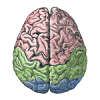5.5: Learning and Memory- Temporal Cortex and the Hippocampus
- Page ID
- 12592
When you think of memory, probably things like "what did I have for dinner last night?" and "how can I remember people's names better?" tend to come to mind. These represent just one category of memory, however. Indeed, memory is ubiquitous in neural networks -- every synapse has the capacity for storing memory, and any given "memory" requires the coordinated actions of millions of such synapses to encode and retrieve. There are many taxonomies of memory, but really the only one you need to know is identical to the functional organization of the brain being provided here. Memory is embedded in every brain area, and the nature of that memory is intimately tied up with what that area does. Motor cortex learns motor memories. Parietal cortex learns things like motor skills -- how to hit a baseball (hint: keep your eye on the ball -- parietal cortex needs visual input!).

There is one brain area, however, that looms so large in the domain of memory, that we'll spend a while focusing on it. This is the hippocampus, which seems to be particularly good at rapidly learning new information, in a way that doesn't interfere too much with previously learned information (Figure 5.9). When you need to remember the name associated with a person you recently met, you're relying on this rapid learning ability of the hippocampus. We'll see that the neural properties of the hippocampal system are ideally suited to producing this rapid learning ability. One key neural property is the use of extremely sparse representations, which produce a phenomenon called pattern separation, where the neural activity pattern associated with one memory is highly distinct from that associated with other similar memories. This is what minimizes interference with prior learning -- interference arises as a function of overlap. We'll see how this pattern separation process is complemented by a pattern completion process for recovering memories during retrieval from partial information.
We'll also see how the learning rate plays a crucial role in learning. Obviously, to learn rapidly, you need a fast learning rate. But what happens with a slow learning rate? Turns out this enables you to integrate across many different experiences, to produce wisdom and semantic knowledge. This slower learning rate is characteristic of most of the neocortex (it also enables the basal ganglia to learn probabilities of positive and negative outcomes for each action across a range of experience, rather than just their most recent outcomes). Interestingly, even with a slow learning rate, neocortex can exhibit measurable effects of a single trial of learning, in the form of priming effects and familiarity signals that can drive recognition memory (i.e., your ability to recognize something as familiar, without any more explicit episodic memory). This form of recognition memory seems to depend on medial temporal lobe (MTL) areas including perirhinal cortex. Another form of one trial behavioral learning involves mechanisms that support active maintenance of memories in an attractor state (working memory in the prefrontal cortex). This form of memory does not require a weight change at all, but can nevertheless rapidly influence behavioral performance from one instance to the next.


